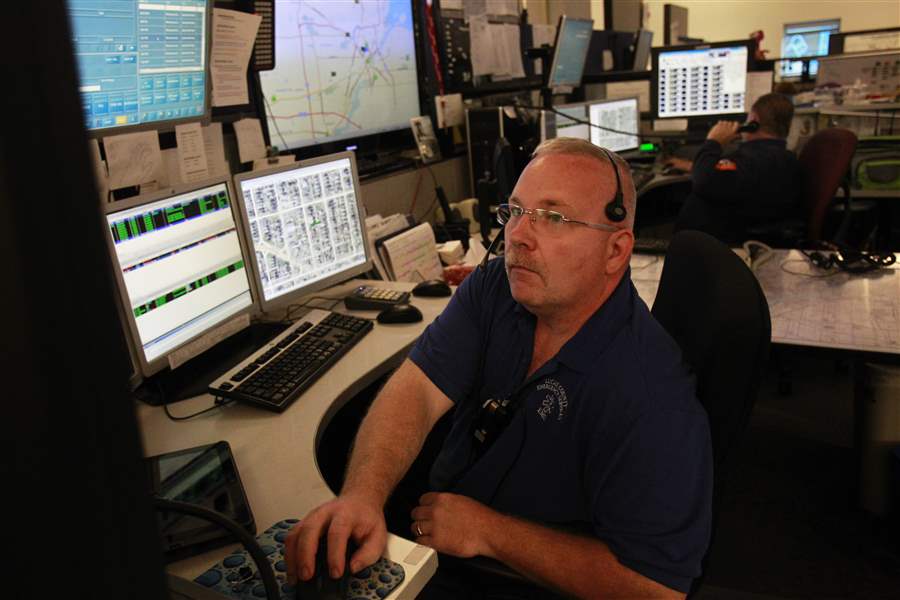
Lucas Co.’s new $6.58M system speedier
Dispatchers can track 1st responders’ locations via GPS
6/23/2014
Lucas County EMS dispatcher Richie Etts, left, works on a computer as Bob Wilt, right, takes a call at the Lucas County 911 Dispatch Center on Monroe Street in Toledo on Friday.
The Blade/Isaac Hale
Buy This Image
Editor's Note: This version corrects the cost of the new dispatch system to $6.58 million.

Lucas County EMS dispatcher Richie Etts, left, works on a computer as Bob Wilt, right, takes a call at the Lucas County 911 Dispatch Center on Monroe Street in Toledo on Friday.
After four years of study, planning, and implementation, a new multimillion dollar computer-assisted dispatch system now in use throughout Lucas County allows dispatchers and emergency responders to manage 911 calls more efficiently.
The $6.58 million system, which combines detailed maps with real-time GPS locations of emergency units, went online at 7:25 a.m. June 11, when dispatchers took their first call at the 911 Center at 2144 Monroe St.
Dennis Cole, the county’s emergency services director, said the county’s 911 dispatchers and their suburban police and fire counterparts now can keep track of cruisers, fire engines, and other mobile equipment, giving them flexibility in sending first responders to emergencies.
The system works by tracking the locations of all emergency vehicles through global positioning. When a dispatcher enters a call into the system, the nearest vehicle or station is automatically identified, and all relevant information — including turn-by-turn directions — is sent to whomever can respond most quickly.
A system database holds the addresses of every building and home throughout the county. The system also allows patrolling officers, firefighters, and paramedics to observe from their vehicles what other first responders or law-enforcement resources are nearby and what other departments are responding.

The new Lucas County EMS dispatch service combines detailed maps with real-time GPS locations of emergency units. The system went online at 7:25 a.m. June 11, at the 911 Center at 2144 Monroe St.
Under the previous computer system, Mr. Cole said, dispatchers had to decide which vehicle they wanted to send for each call, but now they have locations of units available to them on screens, allowing them to pick the closest units.
“I think in the past dispatchers did a good job in deciding on how to send vehicles to emergencies,” he said. “However, this is more efficient.”
Lucas County commissioners approved upgrading 911 operations in September, 2010, when TriTech Software Systems was chosen to implement the new computer-aided dispatching system.
The San Diego-based company was paid $6.58 million, which came from about $2 million in 911 wireless fees and revenue from the county’s five year, 0.7-mill 911 levy. The system’s installation took so long, Mr. Cole said, because of the time needed to enter addresses into the mapping software.
Springfield Township Fire Chief Barry Cousino said the system’s multijurisdictional dispatch functions allow firefighters to pinpoint other units’ locations during mutual-aid calls.
“This allows us to make quick decisions on where the firefighters want to stage and what hydrants to hit on the way. It also allows us to monitor the location of police responding to calls,” he said.
Contact Mark Reiter at: markreiter@theblade.com or 419-724-6199.